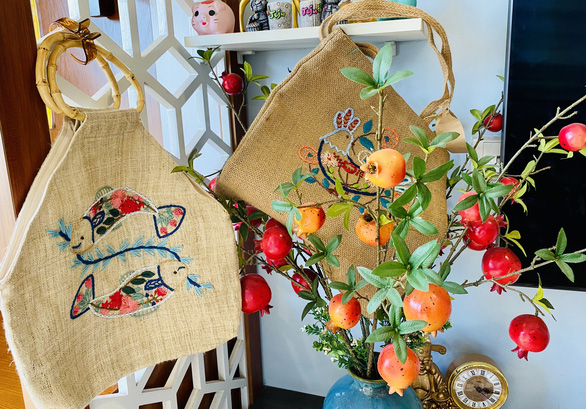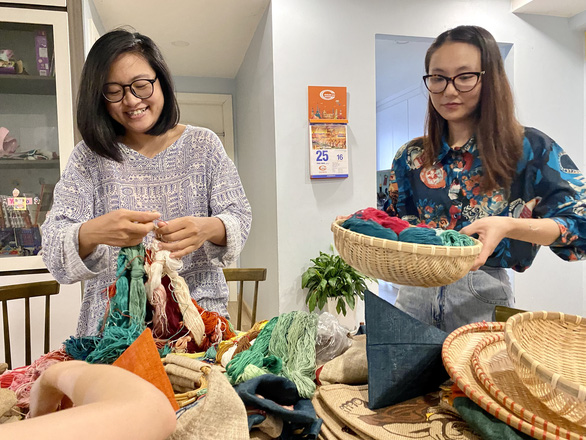Two young fashion entrepreneurs in Hanoi are borrowing inspiration from Vietnamese folk art as they transform ordinary burlap into one-of-a-kind fashion statements.
Dao Thu Trang, 31, and Tran Quynh Anh, 29, founded local fashion brand ‘La La La’ in 2020 with a commitment to promote eco-friendly clothing with a strong connection to Vietnamese culture.
Born in Thai Binh Province, a land known for its widespread production of jute trees and burlap fabric, Quynh Anh has been familiar with the material all her life.
Still, it never occurred to her that the same material used to store crops in warehouses could be transformed into iconic fashion.
Quynh Anh’s preconceived notions of burlap quickly changed after she met Trang, a like-minded peer who inspired her to return to her roots and understand the unadulterated beauty of unprocessed burlap.
Together, Quynh Anh and Trang set out on a journey to transform unassuming burlap into chic, affordable clothing.
During the Lunar New Year season in 2020, Quynh Anh took notice the ubiquity of Dong Ho - a traditional method of Vietnamese painting that focuses on bright, festive color – in Hanoian households.
Believing that Dong Ho fit well with the fashion brand she envisioned, she began to incorporate folk painting- inspired embroidery into her products, an eccentricity unique to the 'La La La' brand that has been attracting major attention in the local market.
For each piece of clothing she designs, Quynh Anh relies on new-school embroidery techniques, given that traditional embroidery does not work well on burlap.
In particular, she focuses on curves, soft features of long chain stitches, and vividly-colored threads which provide juxtaposition the muted burlap textile.
Such unconventional designs make 'La La La' a particularly niche brand given that it can be difficult to match the brand’s clothing with typical styles.
The brand is mostly sought after by a small demographic of young, stylish urban woman who leads sustainable lifestyles, Quynh Anh explained.
“Fashion inexorably shifts over time, which can make an item du jour outdated by tomorrow.”
“Using burlap can lessen the negative environmental effects of discarded clothing given that burlap is biodegradable.”
 |
| Embroidered products by La La La. Photo: Ha Thanh / Tuoi Tre |
Each bag a story
A graduate of Hanoi University of Architecture, Trang spent her first few years after university pursuing a career in sustainable development in France, Italy, Belgium, and Brazil.
While living in Europe, she noticed that eco-friendly products were becoming a major draw for consumers.
The “green product” marketing is maturing in Europe, but the retail ecosystem for these items in Vietnam is still in its infancy.
“Green consumption will increase here, one way or another. It’s the future,” Trang said.
“Despite the numerous challenges in store, I think there are needs for young people to step up and pioneer the movement.”
In La La La’s early days, Quynh Anh and Trang found themselves up against countless obstacles, particularly the weight of burlap and its difficulty to work with.
This challenge was overcome by softening the fabric and removing dust before beginning the tailoring process.
This step is just the beginning. To create a bag, each piece of burlap goes through a rigorous process.
First is the design phase, which requires the team to sample and test fabrics, design the embroidery, and plan out the colors. Only once a design has been settled on can the needlework begin.
With each design, Trang and Quynh Anh strive to tell a distinct story, be it a tale of a whale on the verge of extinction or scenes from Vietnamese folklore.
“We aspire to have each bag tell a story from areas where jute production is high, of Vietnamese cultural values, or tales from our childhoods.
"Our customers can easily spot patterns inspired by Dong Ho paintings, stories of Chi Pheo from writer Nam Cao’s writing, familiar folklore tales, and illustrations of various farm animals,” Trang said.
La La La’s bags sell for VND200,000-300,000 ($9-13) for pieces with small, simple embroidery, and range up to VND1-2 million ($44-87) for larger, more intricate designs.
The brand also has plans to diversify its catalogue by offering linen fabric sourced from Ha Giang, unlocking the potential for more idiosyncratic designs.
Like us on Facebook or follow us on Twitter to get the latest news about Vietnam!



















































